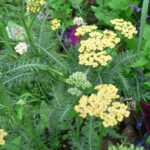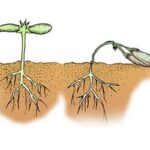If you’ve ever watched a row crop get demolished by a heavy infestation of army worms, you’ll know how they get their name. These ravenous little caterpillars devour entire golf courses and then move en-masse to the next, gobbling with equal vigor.
But what exactly is an armyworm? Are there different kinds, and where are they found? What do they eat? How long do they live? And perhaps the most important, how do you get rid of them? We’ll discuss all of this and more today.
Identification and understanding of which species you’re dealing with are paramount when it comes to control. I’ll give you everything you need to know about this persistent pest and how to wipe it out in your yard.
Subscribe to the Epic Gardening Podcast on
What Are Armyworms?
Armyworms are the heavy-bodied larvae of moths in the family Noctuidae. These nocturnal flyers lay eggs that hatch small larvae, which grow up to 2 inches long and curl up when disturbed. The larvae feed in large numbers, distinguishing them from the cutworm, which feeds singly. While they have varying appearances based on their species, all army caterpillars have a distinctive inverted Y mark on their heads. Egg-laying sites include agricultural crops and the grass blades of pasture grasses, and cool-season grasses. Any plant that is a corn strain or rice strain may be susceptible.
Types Of Army Worms
There are several species of armyworms. We’ll cover the seven most common types and discuss the differences between them.
Mythimna unipuncta, ‘Common Armyworm’, ‘True Armyworm’, ‘White-Speck Moth’
Typically greyish-green or greyish-brown, the common armyworms have long, dark stripes along their bodies. The adult form, the white-speck moth, has fine black dots along its wing tip, and the center of the wings has whitish spots that give it its name. These are common throughout North, South, and Central America, as well as southern Europe, central Africa, and western Asia.
Mythimna separata, ‘Northern Armyworm’, ‘Oriental Armyworm’, ‘Rice ear-cutting caterpillar’
The greenish larvae of this species are also characteristically striped along their body, although they have two wider stripes down the back separated by a lighter colored line, and a brownish head. The moth is greyish with a yellow tinge along the wings. These are common in China, Japan, southeastern Asia, Sri Lanka, New Zealand, Australia, and some of the Pacific islands.
Spodoptera eridania, ‘Southern Armyworm’
Grey-green or blackish-green larvae with a reddish-brown head are a sign of this species. As the larvae mature, they develop into a yellow-striped caterpillar with additional white or off-white stripes. They darken to become a grey-black tone. Adults have brown forewings and off-white hind wings. It’s widespread through central and south America and the Caribbean. In America, it’s typically found in the southern states.
Spodoptera frugiperda, ‘Fall Armyworm’

Fall armyworm larvae are mostly brownish, with two distinctly brighter yellow stripes – sometimes bordered in white – along their sides. These look hairier than other armyworm species. The Spodoptera frugiperda moth has a darker forewing and a white rear wing, with patterns along the forewing. Males are more heavily patterned than females. The fall army worm is common in the early fall and late summer in eastern and central North America and into South America. The fall armyworm caterpillar is a major threat to food security in Africa, which compounds existing hunger and poverty issues.
Spodoptera exigua, ‘Beet Armyworm’, ‘Asparagus Fern Armyworm’, ‘Small Mottled Willow Moth’
These greenish-brown caterpillars have long, dark stripes along their upper sides. The adult moth is a dingy brown with reddish-brown speckled forewings and ivory or beige rear wings. Known widely as an agricultural pest, the beet armyworm originated in southeastern Asia but has spread worldwide.
Spodoptera mauritia, ‘Lawn Armyworm’, ‘Paddy Swarming Caterpillar’
This pest starts as pale green larvae, but mature caterpillars have a green back with white and brown stripes along their sides. Rows of half-circle black spots are visible along the whitish stripe along their sides. The adult moths are greyish-brown with dark patterns. They’re widespread throughout the Pacific islands, as well as from the Red Sea to India and along the Malayan peninsula down to Australia.
Spodoptera exempta, ‘African Armyworm’, ‘Okalombo’, ‘Kommandowurm’, ‘Nutgrass Armyworm’
Interestingly, the older African larvae have different colors depending on whether they are in an area alone or large numbers. Solitary caterpillars are green, while those who congregate are black or dark greyish. Striping occurs along the bodies as in all other species. The adult has a dull grey-brown colored forewing with an off-white hindwing and visible veining. It’s commonly found in Africa and Asia.
Life Cycle of Armyworms
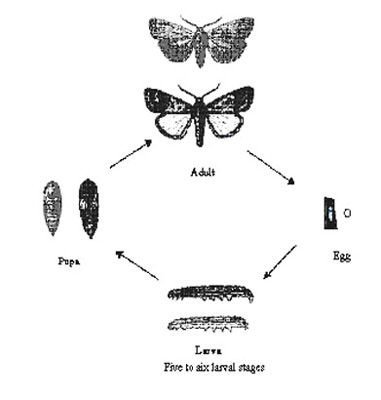
Female moths lay their egg masses on the underside of leaves or grasses. While their location and number vary by species, typically an adult lays between 30 and 80. When the eggs hatch, the young larvae are smaller caterpillars that are almost all grey-greenish, and develop through six larval life stages, called instars, changing to a darker and visibly-striped color depending on their species. True armyworms may have up to nine instars, but most have six. This larval stage when caterpillars feed is when they’re at their most detrimental to crops. After the larval stage, the larger larvae burrow into the soil during the pupal stage. The pupation period for these large larvae varies by species, but they are all 12 to 14 days on average. Then moths emerge in mid-April to carry on the cycle.
The cycle length also varies by species but ranges between 30 to 90 days, most of which is spent in larval stages. The moth typically has a life span of 9 to 14 days. During that time moths lay between 1000 and 1500 eggs. Hence their rapidly spreading and destructive nature. They produce three or more generations per year, with most occurring in the southern region of a state. While most of the cycle takes place in the spring and summer, the fall armyworm also continues into fall. The fall armyworm life cycle takes longer in the autumn and usually lasts until the first killing frost, or when freezing temperatures set in.
Common Habitats For Army Worms
Like the majority of caterpillars, armyworms live where they eat. They are often born on their food source, consume that, and move on to other hosts. In heavy infestations, you’ll see fall armyworms marching to the next host from their last. They tend to feed during humid nights and early morning and hide under leaves on sunny days. Most of these worms do not overwinter in the soil and instead migrate to warmer climates for the winter. North American species typically survive the winter in southern regions such as Southern Florida, the southeast, or other frost-free locations. Most species typically stay in a pupal state over the winter.
Identifying Army Worm Damage
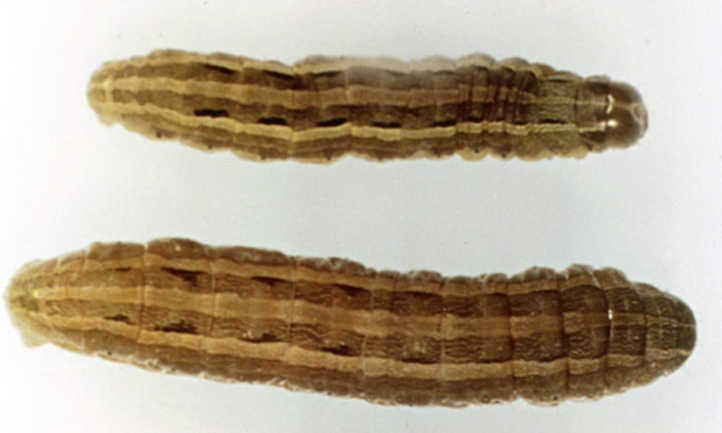
Due to the wide variety of foodstuff susceptible to armyworm attacks, we’re going to break this segment down by type of army worm. Note that grass pastures may have patches of dead grass in them from fall armyworm damage. In tall fescue, the damage comes in the form of cut seed heads and destroyed foliage. Armyworm damage is extensive in most cases. They act like cutworms on grasses, and on food crops, they skeletonize larger leaves. On some crops such as corn or fruits/melons, fall armyworms bore into the cob or fruit to eat that as well. This pest (especially fall armyworm caterpillars) is known for the economic damage it causes!
Common Army Worm: Many Gramineae grass species including wheat, barley, sugarcane, corn, sorghum, oats, rice, and rye. Can also feed on other crops such as sweet potato, alfalfa, pepper, artichoke, parsley, celery, bean, onion, cabbage, lettuce, carrot, and cucumber.
Northern Army Worm: Most commonly consumes maize, sorghum, and rice. May also affect other Gramineae species.
Southern Army Worm: The southern armyworm has a wide range of hosts, including avocado, beet, cabbage, carrot, citrus, collards, cowpeas, eggplant, okra, peanut, pepper, potato, sunflower, sweet potato, tobacco, tomato, velvet bean, and watermelon. They also eat weeds, although pigweed and pokeweed are their favorites.
Fall Armyworm: Fall armyworm feeds on more than 60 and up to 80 different varieties. Among these are forage and crop grasses, corn, alfalfa, soybeans, cotton, and most vegetable crops. Fall armyworms arrive in late summer and early fall.
Beet Army Worm: An extremely large list including sugar and table beets, beans, asparagus, lettuce, peas, celery, potatoes, cotton, tomatoes, tobacco, cereal grains such as wheat and corn, oilseed plants such as flax, multiple flowering plants, and a wide variety of weeds.
Lawn Army Worm: While rice is the preferred crop for this pest, it’s also known to feed on nutgrass, cabbage, kale, cauliflower, rapeseed, mustard, broccoli, turnip, sugarcane, and a wide variety of grasses including lawn grasses.
African Army Worm: Almost exclusively, the African armyworm feeds on cereal, pasture, and grassland grasses. Most cereal crops, including maize, sorghum, millet, rice, wheat, and oat seedlings. A study has shown that two larvae can eat an entire 10-day-old maize plant on their own, which makes these pests particularly dangerous to corn crops.
Controlling Armyworms
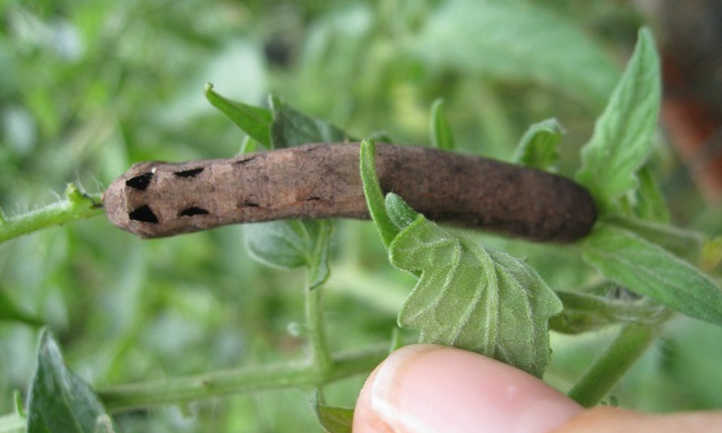
You might be thinking, ‘How do I get rid of armyworms?’ Well, the first line of defense is to hand-pick them off of plants and drop them into a bucket of warm soapy water to drown. Or use a sweep net to collect them and throw them in the water. But there are other options aside from a sweep net or handpicking for killing them. There are prevention methods too!
Cultural Control
There are a surprising number of armyworm predators. Cultivating natural enemies is a great integrated pest management strategy, even more than using organic methods. Among these predators are birds, especially crows, starlings, and bobolinks. Some frogs and toads also happily consume worms and adult moths. If you’ve been asking how to get rid of armyworms in grass, especially for your lawn or grain crops, attract these natural predators. However, birds may also pick at grain crops, so place bird netting over your crops if they become a problem.
Encourage tiny parasitic wasps in your garden. These prey on insects regularly, laying their eggs inside or on top of larvae. As they hatch, juvenile wasps feast on the larvae and kill them. They do double-duty as pollinators, although they are nowhere near as good at pollinating as bees are. Ladybugs and lacewings eat the eggs of the worms when they find them.
A less commonly-known predator of these worms is the ground beetle from the Calosoma genus, which eats most types of caterpillar. Ground beetles are not usually available commercially, but they naturally migrate to areas where fall armyworms and other caterpillar-type larvae are common.
Biological Removal Of Armyworms
An excellent choice for control is two strains of BT spray: Bacillus thuringiensis var. kurstaki and Bacillus thuringiensis var. aizawai. Available in both a liquid formula in sprays and a powdered version, these bacteria poison caterpillars. They’re effective not only on fall armyworms and others, but on other caterpillars such as cabbage loopers, cabbage worms, tomato hornworms, and cutworms.
Beneficial nematodes help from within the soil. These microscopic soil-dwellers feast on the pupae of fall armyworms. Nematodes on the soil surface attack larvae that may be burrowing down to pupate. But they’re not as effective on the soil’s surface unless it’s moist.
Insecticidal Control
Azadirachtin sprays are also quite useful as a method for killing armyworms. Azadirachtin, the naturally-occurring active ingredient that makes neem oil so effective, smothers most eggs of these worms and kills the larvae.
Other horticultural oils like neem oil are also effective against armyworms but have lesser amounts of azadirachtin than a pure form of neem oil does. A spinosad spray is just as effective as the other recommendations listed. Like Bt and azadirachtin, it works against multiple pests including the entire caterpillar family, asparagus beetles, and potato bugs. Ensure you follow the label and instructions for each insecticide’s intended use.
Preventing Armyworms
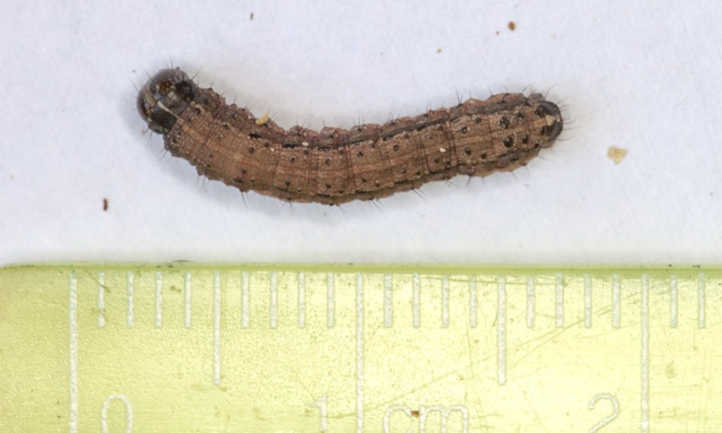
Can you prevent armyworms? You can! Ensuring that your yard is full of beneficial predators is a great step. Cultivate flowers and herbs that attract lacewings and ladybugs such as dill, caraway, coriander, yarrow, marigold, and fennel. Most of these draw in predatory wasps as well. Tansy, lemon balm, and parsley lure them in as well. While the goal is to have beneficial predators devour your eggs and occasionally the pests themselves (like aphids), ensuring that they have a constant food supply on hand encourages them to stay year-round. If you can keep the adults away from your crops, they can’t lay their eggs on them. While this doesn’t work as effectively on grasses, using a floating row cover over your other food crops protects them from armyworms and other pests.
Spreading some diatomaceous earth over the leaves and stems of your plants may encourage them to find another source of food. Food grade diatomaceous earth is harmless to people and pets but is like crawling over razor blades to the super-sensitive skin of army worm larvae. Finally, check with your cooperative extension office to see if there are specific controls and prevention methods for the worms in your region.
Frequently Asked Questions
Q: Are army worms harmful to humans?
A: Not directly, but these caterpillars can cause a lot of destruction to crops. Fall armyworms are even more destructive, as they are the only caterpillars we discuss here that feed for two seasons.
Q: What kills army worms in lawns?
A: The best control for lawn pests, like fall armyworm, is beneficial nematodes.
Q: What does an army worm turn into?
A: It grows into a nocturnal moth.
Q: Will grass grow back after armyworms?
A: It can, but recovery takes time. So the best course of action is to prevent them! Check to see if your cooperative extension office has some lawn solutions, especially for the pesky fall armyworm.
Q: What happens if you don’t treat army worms?
A: They’ll skeletonize leaves and kill grasses if they aren’t controlled. Fall armyworms are most destructive as they live for multiple seasons.




